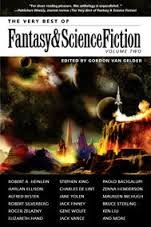“…the dragon
Griaule, a vast mile-long beast who had been struck immobile yet not lifeless
by a wizard’s spell, and who ruled over the Carbonales Valley, controlling in
every detail the lives of the inhabitants, making known his will by the
ineffable radiations emanating from the cold tonnage of his brain. From
shoulder to tail, the greater part of Griaule was covered with earth and trees
and grass, from some perspectives appearing to be an element of the landscape,
another hill among those that ringed the valley; except for sections cleared by
the scalehunters, only a portion of his right side to the haunch, and his
massive neck and head remained visible, and the head had sunk to the ground,
its massive jaws halfway open, itself nearly as high as the crests of the
surrounding hills.” (The Scalehunter’s Beautiful Daughter)
A quiet evil, the Dragon Griaule exudes malevolence in subtle
ways. Shepard examining several of them,
six in fact, the eponymous collection brings together the stories published as
of 2012, and is, in most ways, the author’s magnum opus. Appearing irregularly over a period of almost
thirty years, the five novellas and one novelette are pleasingly
unconventional, spellbinding, humanist, haunting, and smoothly well-written—each
story highly unique within the context.
The following is a brief summary of each.
In dialogue with the metaphors of life, “The Man Who Painted
the Dragon Griaule”
(1984) is literary fantasy at its peak, and is the story of Meric Cattanay. Griaule a powerful evil, the men of the
nearby village have hired wizards and mages for ages to try to kill it once and
for all, but with no success. It is
Cattanay who suggets trying to kill Griaule by painting him—literally, not on
canvas. Painting a dragon of such size a
lifelong process, the story is told in windows of time in Cattanay’s life as he
deals with the exigencies of handling the task he has taken on. Utilizing one
of fantasy’s most recognized, if not the most recognizable trope for literary
purposes, the novelette is a beautiful tale of one man “conquering a dragon”.



























